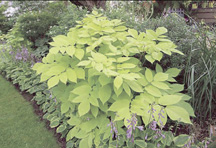A welcome Chinese import

does well even in shady conditions would be wise to consider Aralia cordata, aka spikenard.
By RON DIETER
For The Weekly Post
“So, how long is this social distancing stuff supposed to go on? I need to know because my wife keeps trying to get back into the house.”
It’s not often that I actually laugh out loud when I read the various memes posted on the internet, but this one just tickled my innards. Paul Gil, in an essay describing memes on Lifewire.com, writes “memes behave like a mass of infectious flu and cold viruses, traveling from person to person quickly through social media.” A particularly vivid description, given the situation we find ourselves in today, thanks to our “friends” in China’s Communist Party.
We can, however, thank China for at least one good import –Aralia cordata, an herbaceous perennial native to eastern China and to Japan and Korea.
Aralias are useful as background plants in shady garden borders. Shoots of the plants have culinary uses in Asian countries, but folks over there tend to eat a lot of strange things.
I’m told by the horticultural cognoscenti that the common name for Aralia cordata is “spikenard,” but most folks just call it aralia. That’s how it goes with common names. Some ain’t so common.
Easy to grow, aralias prefer rich, moist, welldrained soils but we’ve had good luck with them at our place where the soil is not the best. In good ground and with plenty of moisture, aralias can grow up to six feet tall in a single season.
Four feet is the maximum in our garden conditions. The growth habit is similar to that of peonies. Emerging shoots becominG sturdy stems bearing the foliage. Each aralia stem holds an array of threeinch pointed leaflets along its length. The numerous stems form a “bush.” The leaflets are yellow-green in spring turning bright green in summer. Spikes of tiny white flowers begin to appear in midsummer, which honeybees find attractive.
A full-grown aralia could easily be mistaken for a woody shrub, but like peonies, the plant dies back to the ground where it sits tight till the next spring. Each year, the clump gets bigger and can be divided by cutting out a portion with your trusty spade in springtime.
Ten or 15 years ago, a specific cultivar of Aralia cordata was found that refused to turn green in the summer. The foliage emerges a bright golden color in early spring and holds it all the way through autumn. In full shade the color leans toward chartreuse. The more sunlight the more golden it becomes. We get plenty of golden color in our lightly shaded garden.
The cultivar was named “Aralia ‘Sun King’” and introduced to the public. ‘Sun King’ rapidly became popular with gardeners across the country. Today any self-respecting nursery offers ‘Sun King’ in their perennial department. ‘Sun King’ earns its keep in the garden because its brilliant color lightens up dark areas and contrasts so well with other colors. The maroon foliage of plants like corals bells, Japanese maples, and even coleus comes alive when pairedwith ‘Sun King.’
Even hosta gardeners, eager for shade partners, use ‘Sun King’ to put some
interest and height in their hosta collection. And while deer may munch on hostas, they have no taste for aralia and just walk on by.
If you’re looking for an easy-care patio pot, ‘Sun King’ is both elegant and stunning all by itself in a big blue pot. Just make sure you maintain adequate moisture or the foliage may burn, especially in full sun. Afternoon shade is best.
For years, Aralia ‘Sun King’ was in the running for the Perennial Plant of
the Year (PPOY) award from the Perennial PlantAssociation. This year the
PPOY award finally went to ‘Sun King.’ Now more gardeners will give it a try. If you’d like one, I’ll trade you a start of ‘Sun King’ for for a roll of toilet tissue.







